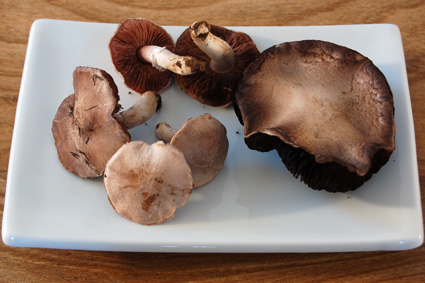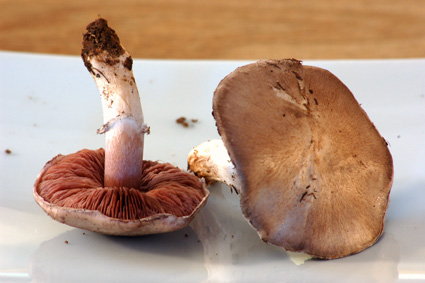I found some wild mushrooms today. But, as I can't quite figure out what they are, I'm not eating any. See, I've been reading up on wild mushroom hunting lately - my interest piqued by a variety of factors1 - and it's an entirely new world of things out there to eat.
Potentially. Given some of the charming descriptions of various mushroom toxins, this is the sort of thing best taken slowly.

So here they are. Most of them, anyhow; it was an overflowing handful. I'm fairly sure that there were a few more coming up where I found them, as well. As soon as I got them home, I started searching through the various identification books2 I've got. The verdict? Unsure. I've narrowed it down to (most likely) the Agaricus genus, but can't find a clear match. The good old field mushroom, Agaricus campestris, is the closest thing, but just not close enough.
Ring on the stalk, with a delicate texture, missing on some? Yup.
Lack of a cup-like volva at the base of the stalk? Yup.
Gills free from the stalk? Yup.
Stalk separates easily from the cap? Yup.
Gills pink when young, becoming dark chocolate in maturity? Yup.
Spores chocolate brown to blackish? Yup. (Chocolate brown, I'd say.)
Staining yellow? Nope. Not staining any color.
Cap color? Ranging from pale tan to chocolate brown around the edge, especially on the largest and oldest one.
It even smells just like a crimini or white button mushroom. Even a brief taste3 suggests that.
The primary reason it doesn't seem like Agaricus campestris? The edges of the caps are irregularly turned up on the older mushrooms. I've seen pictures and descriptions of other mushrooms that do that, but rarely for the Agaricus species. I'd think that would be a distinctive enough feature to be worth noting - and of the three books handy, not a single one mentions it. But, hey, I'm getting some good use out of these books, all of which are careful to note that there are untold species out there, either unidentified or not well enough known to make it into any (let alone every) guide.

They're also alerting me to the many, many bizarre characteristics of the fungi out there. As just one example, take the range of mushroom toxins. Utterly fascinating.
A few include:
- Amatoxins
About a half dozen of these chemicals appear in the group called the deadly amanitas, as well as some Lepiota and Galerina fungi. They even occur, in extremely tiny amounts, in chanterelles and porcini, which are pretty much tops in terms of edibility.
One book notes amatoxin poisoning as being "of the worst type". Six to twenty-fours hours pass before abrupt, violent vomiting and diarrhea begins. This coincides with serious damage to the liver, kidneys, heart, and central nervous system. No wonder that species such as Amanita virosa and A. phalloides have picked up names like destroying angel and death cup. - Gyromitrins
These potentially fatal compounds are usually found in the false morels. Some old guides considered these mushrooms edible - following parboiling and discarding the water or drying, both of which destroy nearly 99 percent of the toxin - but that doesn't seem to be the case anymore. Even the small amount that remains has proven highly carcinogenic in small mammals, and there's always the possibility of not doing it well enough.
Especially since the toxins have a similar delayed onset, followed by up to two days of vomiting and diarrhea, then potential liver and/or heart failure. So, even if it doesn't kill you, you might wish that it did.
It's interesting to note that one of the false morels that contains gyromitrins is Gyromitra esculenta. The esculenta portion of that means "edible", which it most certainly isn't. Not on my list, anyhow. - Orellanine (Cortinarin A and B)
This, I think, has to be the most insidious mushroom poison. It show up in some Cortinarius species, and isn't too different, chemically, from the amatoxins. The symptoms include an intense, burning thirst, gastrointestinal disruption, headaches, aches and pains, spasms, and loss of consciousness. Then rolls in the kidney (and sometimes liver) damage. But why's it so insidious?
The onset of the symptoms usually comes three to fourteen days after eating the mushrooms. Up to two weeks? Even if there were something to do about it - the book notes that "[n]o specific therapy is known" - how the hell would you figure out what was causing the problem? - Muscarine
Even though this one's characteristic in the fly amanita - the red toadstool white white spots from a million illustrations - it's not the primary toxin there. It does show up in a variety of other species, including Clitocybe dealbata, the so-called "sweating mushroom".
So-called because the symptoms of muscarine poisoning include greatly increased secretions of sweat, saliva and tears, in addition to the usual diarrhea and vomiting. It can be deadly in severe cases. - Ibotenic acid and Muscimol
Here're the main toxins in Amanita muscaria. Sometimes it results in serious vomiting, though it's best known for the hallucinogenic (and related) effects: confusion, muscle spasms, delirium, and hallucinations. In certain areas - specifically parts of Siberia - these mushrooms were (or are) used for their intoxicant effects.
Here, though, the toxins skew a little more to the vomit-all-day-and-wish-you-were-dead side. Apparently, at least in central Pennsylvania, there are virtually none of the hallucinogenic side effects - one book notes that some here have tried, but the author couldn't find anyone who'd even entertain the notion of trying again. - Psilocybin-Psilocin
These would be the chemicals causing "particularly vivid and dramatic" hallucinations. I'm also informed that simply picking mushrooms containing these toxins can be a federal crime - i.e., possession of illegal substances of some sort - so it pays to be careful about what goes into the harvesting basket. - Coprine
If I could have a favorite mushroom toxin, this would be it. Hands down.
As near as I can tell, this only occurs in the alcohol inky cap, Coprinus atramentarius, an edible mushroom that's generally considered quite tasty. See, it's not toxic on its own; it's only when consumed with alcohol that it becomes a problem. One source suggests abstaining from alcohol twenty-four hours prior to and up to five days after eating, just to be safe.
Symptoms don't take long to appear; about thirty minutes is all. First, the person feels hot and the skin flushes red, and breathing becomes rapid and difficult. Then come the usual suspects of violent headache, nausea, vomiting, and more or less feeling like hell for a few hours. Some people are more or less sensitive, but it's worse with more mushrooms, more alcohol, and a shorter period between consumption of the two.
It seems that a certain cycolopropyl amino-acid derivative in the mushroom gets turned into cyclopropanone in the body, which then interferes with the liver's ability to metabolize ethyl alcohol. A synthetic drug, disulfiram, does pretty much the same thing when given to alcoholics to them curb their drinking. Neat!
Of course, I'd be thrilled if I could just find a few good morels or chanterelles next year.
* * * * *
1For starters, I'm anxious to go morel hunting come spring. Assuming that I can actually spot them, they're dead easy to identify. Then there's the fact that chanterelles and black trumpets grow in this area - two mushrooms of significant culinary renown. Top that off with the recent "Steve, Don't Eat It!" on the sulfur shelf, and I'm anxious. Oh, and finding edible Coprinus micaceus and Coprinus comatus mushrooms while out walking in Madison didn't hurt.
2The Mushroom Hunter's Field Guide by Alexander H. Smith and Nancy Smith Weber; The New Savory Wild Mushroom by Margaret McKenny and Daniel E. Stuntz; and Field Guide to Wild Mushrooms of Pennsylvania and the Mid-Atlantic by Bill Russell. Thanks, library card!
3At least one of the guides notes that it's impossible to poison oneself by simply touching a mushroom to the tongue for a taste. It uses the specific example of the destroying angel, Amanita virosa, perhaps the deadliest mushroom in the world. Half a cap of that mushroom will most likely kill an adult.
4I'm planning on leaving the whole poisoning aspect in the realm of abstract understanding.

No comments:
Post a Comment